UK Health Research Analysis 2009/10
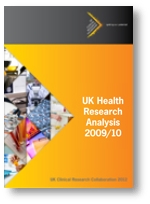
Key Links
Executive Summary
This analysis compiles information about the expenditure on health relevant research in the UK. Comprehensive information about research undertaken in 2009/10 and supported by the 12 main public and charitable funders of health research in the UK was used to examine health relevant research activity in detail. The monitoring and strategic co-ordination of health research is important given that it represents a substantial part of the UK science base, and has been shown to provide an exceptional rate of return to the UK economy.
For the first time the total expenditure on health relevant research and development by UK businesses, public sector organisations and not-for-profit organisations is estimated using data from ONS, HESA and the UKCRC. Our estimate for the total expenditure on health-related research and development, performed by UK public, private and not-for-profit organisations (although not necessarily conducted in the UK) in 2009/10 is approximately £8bn. This represents almost a third of all research and development expenditure in the UK. Over half of this (approximately £4.5bn) is carried by the private sector, leaving in the region of £3.5bn of activity in the public and not-for-profit sectors. Significant complementarity is seen between the private, public and charitable investments in health research.
Using the Health Research Classification System (HRCS), almost 12,000 peer reviewed awards from the 12 participating publicly and charitable funded organisations were categorised in detail. These awards total £1.6 billion of direct expenditure on health research in 2009/10. Taking into account a further £824m of spend on research infrastructure, this totals just over £2.4bn of expenditure in support of health research in the UK for that year. It is suggested that this “bottom-up” analysis includes almost all public and charitable funded health research in the UK, and is estimated to cover a significant proportion of the fundamental and translational health research occurring in the UK. We also suggest that the remaining £1.1bn of research performed in the UK outside of the private sector largely comprises quality related funding for Universities from the UK funding councils, overseas funding for UK research and NHS supported clinical academic posts.
Comparisons were made with expenditure on health research in 2004/05 using a UKCRC dataset published in 2006. Several significant differences were noted between the 2004/05 and 2009/10 portfolios:
- Overall annual funding for health-related research included in this analysis was larger by just over 50% in real terms (from £1bn in 2004/05 to over £1.6bn in 2009/10). It was noted that part of this increase was due to the move to full economic costing, but that both public and charitable funding agencies had been able to significantly increase the support available for health research.
- 60% of the health research portfolio analysed in detail is focussed on the basic understanding of health and disease. Areas relevant to “underpinning” and “aetiological” research received over £226m more funding in 2009/10 compared to 2004/05 in real terms. Although the proportion of overall funding allocated to these areas was lower in 2009/10 compared to 2004/05 they remain the areas against which most funding is allocated.
- Within the areas of “underpinning” and “aetiological” research, there was more research with relevance to methodology in the 2009/10 portfolio compared to the 2004/05 dataset.
- Funding in real terms for prevention research, an area identified as in need of expanding in 2006, had more than twice as much funding in 2009/10 compared to 2004/05 (from £27m to £61m), and the main focus of this was on primary prevention research.
- An additional £131m in real terms was spent on research categorised as treatment development and treatment evaluation in 2009/10 compared to 2004/05. These categories represent more translational areas.
- Spending on respiratory medicine research was almost three times higher in real terms in 2009/10 compared to 2004/05 (changing from a small portfolio of £10m in 2004/05 to £28m in 2009/10).
- Funding for research categorised as relevant to oral/gastrointestinal diseases in 2009/10 was twice that of 2004/05 (a real terms change of £15m to £30m).
- £100m more was spent in real terms on research relevant to cancer in 2009/10 compared to 2004/05 (total spend in 2009/10 £320m), and £35m more on research relevant to neurological diseases (total spend in 2009/10 £161m).
- The proportion spent on research for mental health (total spend in 2009/10 £90m) and infectious diseases (total spend in 2009/10 £177m) was higher in the 2009/10 dataset compared to the 2004/05 portfolio.
- Between the two datasets, five years apart, there were small differences in the distribution of health research funding across UK regions and cities. Both Oxford (+1%) and Cambridge (+0.5%) had a higher share of total health research funding, whereas the share of funding for London institutions was the same at just over a third of the total (33.4%).
- £25m more health research funding was identified for institutions based in Wales in 2009/10 compared to 2004/05, in real terms. Similarly £43m more funding for health research for institutions in Scotland was identified 2009/10 compared to 2004/05. Funding for institutions in Northern Ireland was £4m higher in 2009/10 compared to 2004/05 in real terms. In England, research funding increased by £474m in real terms over the same period.
- The exercise compiled details of almost £60m of funding provided to support health research outside the UK.
The changes reflect in part the impact of a number of initiatives aimed at boosting clinical research and experimental medicine, including joint initiatives developed under the auspices of the UKCRC and OSCHR. This co-ordination is aimed at delivering a step-change in the way that health research is supported to the benefit of patients, the NHS and the wider healthcare economy. The funding organisations contributing data to the analysis have different drivers and approaches to funding research and will use the findings from the analysis in different ways.
HRAF proposes that a process for the regular compilation of portfolio data, and a community of practice to enhance the use of the HRCS nationally and internationally should be established. Preliminary discussions have already taken place under the auspices of the European Science Foundation (ESF) and European Medical Research Council (EMRC), to highlight and encourage use of the HRCS across Europe. In addition HRAF will explore approaches to automate the coding of awards using the HRCS to make future analysis easier, cheaper and more systematic.
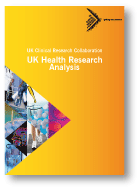
Key Links
- UK Health Research Analysis 2004/05 report (PDF)
- Data from the the 2004/05 analysis (CSV spreadsheet)
- Data collection and analysis guidance
Executive Summary
The UK Clinical Research Collaboration (UKCRC) is a partnership of the main stakeholders that influence clinical research in the UK. The Collaboration was set up in 2004 with the aim of establishing the UK as a world leader in clinical research. One of the goals of the UKCRC is to develop a coherent approach to funding health related research. A key step in this process is to map the current UK-wide research portfolio and create an evidence base that can be used to inform individual and joint planning and to facilitate coordination between funders. This report presents the results of this mapping exercise – an analysis of the directly funded UK research portfolios of the 11 largest government and charity funders of health related research. Collectively the portfolios of the participating organisations represent the overwhelming majority of non-commercial health research in the UK. It is the first time a national analysis of the distribution of research funding across all types of research activity and all areas of health and disease has been carried out on this scale anywhere in the world.
There are a number of elements of funding that are essential to support research activity. This analysis focuses exclusively on directly funded peer reviewed research awards where funding can be directly attributed to a clearly defined set of research objectives such as training awards, projects, programmes, institutes and centres. It is not designed to be a national audit of all spending on biomedical and health research by the participating funders and consequently does not include indirect support costs such as administration, infrastructure and core support costs (e.g. for the Wellcome Trust Sanger Institute); UK Health Departments’ R&D support costs for NHS providers; or research taking place outside the UK. The analysis provides an overview of research taking place in the UK during the 2004/2005 financial year and is based on a total of 9,638 peer reviewed awards, representing a total spend of £950m on this type of research during this period.
In order to conduct the analysis, a central UKCRC Research Database was established containing the directly funded health relevant research portfolios of the participating funders. A bespoke Health Research Classification System (HRCS) was developed to classify the research portfolios on the Database. The HRCS is a two dimensional analytical framework, enabling research to be classified according to the type of research activity taking place (Research Activity Codes) and according to the area of health or disease under investigation (Health Categories). The Research Activity Codes organise research into eight top level codes that cover the full spectrum of biomedical and health research. Each of these eight main codes is further subdivided to give a total of 48 Sub-codes. The Health Categories contain 21 separate groupings that encompass all diseases, conditions and areas of health.
Every research award on the Database was classified using the HRCS to reflect the central aim or ‘centre of gravity’ of the research taking place within the duration of the funding. Rigorous quality control measures were taken to ensure accurate and consistent coding across the portfolios of the different funders. The analysis presented in this report is primarily on the collective research portfolios of the participating organisations and focuses on the Health Categories and the main eight Research Activity Codes.
Analysis of the distribution of the combined research funding across the eight main Research Activity Codes indicates that one third of spending is concentrated in Underpinning research, aimed at understanding normal functions and processes. Aetiology, which includes all studies into the risk, cause or development of disease, also represents one third of the total spend. The remaining third is spent on research into diagnosis of disease, development and evaluation of treatments, disease management and organisation of healthcare. A total of 2.5% of funds is dedicated to research focused on the primary prevention of disease.
The report shows that the distribution of funds across different types of research activity varies between individual funding organisations and across different areas of health and disease. Of the total research funded, 25% is applicable to all diseases or relevant to general health and well-being, whilst 75% relates to research that can be attributed to specific diseases and areas of health. For the research funding that is specific to individual areas of health and disease, two thirds of the aggregate funds are spent on Cancer, Neurological, Infection and Cardiovascular research. In general the pattern of research funding follows the ranking of burden of disease as measured by Disability Adjusted Life Years (DALY) rates for the UK. Exceptions to this trend were observed in the areas of Respiratory and Oral and Gastrointestinal, where the comparative research funding is lower than the relative burden of disease and for Infection, where the relative research funding is higher than the UK DALY ranking.
Analyses have previously been carried out in the UK in single disease areas such as cancer but an overview of research funding across all diseases has not been attempted before. This report provides a breakdown of the relative research funding for 19 individual areas of health and disease. A geographical distribution of funding within the UK is also provided.
The pattern of direct research funding observed in this study is a composite of 11 different research portfolios. This pattern has emerged over a period of time and has been shaped by a variety of different factors. In any given area of health related research the factors that might influence the amount of activity include: scientific opportunity; size and quality of the research workforce; ‘researchability’ or tractability of an area; burden of disease; and the level of charity fundraising. There is no correct or appropriate shape for the overall UK portfolio and, as this type of exercise has not been conducted before, there are no comparative national analyses available.
The funding organisations participating in the analysis are a mixture of public and charity bodies. They have different drivers and approaches to funding research and will use the findings from the analysis in different ways. The data in this report represent a snapshot of ‘live’ funding for the financial year 2004/2005. Since then the participating organisations have launched a number of initiatives aimed at boosting clinical research and experimental medicine, including joint initiatives developed under the auspices of the UKCRC.
The UKCRC brings together key stakeholders to address complex issues that could not be tackled by a single organisation. This analysis represents a powerful example of joint working between the main funders of health research in the UK. In the future the UKCRC Secretariat will explore the feasibility of including data from smaller medical research charities and Industry to add to the picture of health research in the UK.
The HRCS underpins five important UKCRC analysis reports which together provide a comprehensive overview of non-commercial health research funding in the UK. The analysis reports have been disseminated widely in the UK and had a major impact, providing the basis for high level strategy discussions and informing a number of joint funding initiatives.
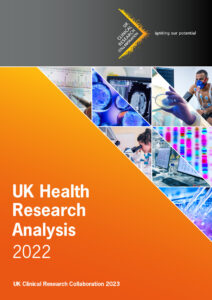 The fifth report in the series was available from December 2023, formally published in February 2024. The UK Health Research Analysis 2022 is the most comprehensive report to date, collating information from 173 organisations reaching an estimated spend total of over £5 billion.
The fifth report in the series was available from December 2023, formally published in February 2024. The UK Health Research Analysis 2022 is the most comprehensive report to date, collating information from 173 organisations reaching an estimated spend total of over £5 billion.
For more information, visit the 2022 report page, or you can download the 2022 report PDF directly.
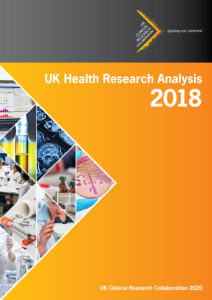 The fourth report in the series was published in January 2020. The UK Health Research Analysis 2018 further expanded on past analyses to collate information from 146 organisations, expanding to wider government departments, royal colleges, academies and learned societies.
The fourth report in the series was published in January 2020. The UK Health Research Analysis 2018 further expanded on past analyses to collate information from 146 organisations, expanding to wider government departments, royal colleges, academies and learned societies.
For more information, visit the 2018 report page, or you can download the 2018 report PDF directly.
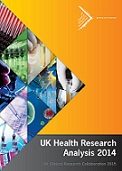
The third report, the UK Health Research Analysis 2014, was published in August 2015. This report expanded on the previous analyses to include 64 UK charity and public health research funders.
For more information, visit the 2014 report page, or you can download the 2014 report PDF directly.

The second report, the UK Health Research Analysis 2009/10, was published in 2012. This report showed the significant changes in the UK health research landscape five years after the original. This report added new features to the report, including an assessment of research infrastructure and an estimation of the total UK Health R&D expenditure.
For more information, visit the 2009/10 report page, or you can download the 2009/10 report PDF directly.

The success of the first UK Health Research Analysis in 2004/05 was followed by an international workshop in 2009. This allowed those involved in the UK project to share their experiences with other international research organisations and promote the HRCS as an international standard.
For more information, visit the 2009 workshop page, or you can download the 2009 workshop PDF directly.

The original national analysis featured eleven of UK’s largest government and charity health research funders and award data from the financial year 2004/05. The report of this analysis, UK Health Research Analysis (2004/05), was published in 2006.
For more information, visit the 2004/05 report page, or you can download the 2004/05 report PDF directly.
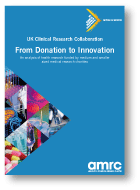
The HRCS was also used to analyse the funding activities in 2004/05 of 29 medium and smaller sized members of the Association of Medical Research Charities (AMRC). This report, From Donation To Innovation, was published in 2007.
For more information, visit the From Donation to Innovation report page, or you can download the report PDF directly.
For further details on these reports and the UKCRC, see the UKCRC website.
Executive Summary
The UKCRC promotes the use of the data collected for the UK Health Research Analyses. The processes by which data is collected and how the data is published are detailed in the ‘Data Collection’ sections for each report.
The datasets used in the analyses are also made freely available and can be found at the bottom of this page. You are welcome to make use of these data but:
- We strongly recommend you contact us if you are seeking to re-analyse the public datasets.
- These datasets have been collated specifically for these analyses and timepoints – analyses conducted outside of these conditions may require updates from the contributing organisations
- We also use a bespoke methodology for the analysis which may not be appropriate for all studies of health research funding data
- Any re-use of the data or figures should be fully acknowledged with formal citations in any publications that use this information.
- This helps us to better understand the value of these data to the research community and ensure that the UK Health Research Analyses continue to provide supportive information for research in the future
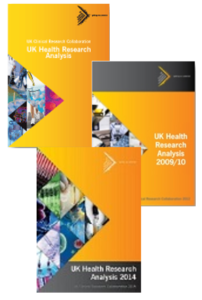
UK Health Research Analyses Datasets
- Conditions of use for 2004/05 and 2009/10 datasets
- Conditions of use for 2014 dataset
- Conditions of use for 2018 dataset
- Conditions of use for the 2022 dataset
Citing the most recent analysis (2022)
When citing the report and/or onward use of the dataset please use the following acknowledgement:
“UK Health Research Analysis 2022 (UK Clinical Research Collaboration , 2023) https://hrcsonline.net/reports/analysis-reports/uk-health-research-analysis-2022/”.
The reports in the UK Health Research Analysis series, their associated data and the HRCS coding system are available for onward use as part of our creative commons licence.
The UKCRC encourages the further use of all UK Health Research Analysis data. We hope that continued use will emphasise that availability of portfolio information and sharing funding data can be of great benefit to research organisations and provide evidence for more strategic decision making.
The HRCS is an analytical framework where assigned codes are directly linked to award funding using a standardised coding and apportionment system. This means that amounts of investment associated with specific areas of research can be analysed in a reproducible manner with no double counting of total award funds.
If you are considering recreating the UK Health Research Analysis, we recommend you begin by looking through the pages for the latest analysis in 2022, which includes:
- The 2022 Data Submission Guidelines
- The 2022 Frequently Asked Questions (FAQ)
- The 2022 Data Publicity Statement
- The 2022 Qualitative Submissions guidance
- The 2022 Data Entry Spreadsheet (xlsx format file)
We also published a paper in 2016 on the pros and cons of performing the analysis in 2014. This article is available from the journal Health Research Policy and Systems. Alternatively, you can contact us if you have further queries and we will be happy to assist you.
Analysis of award data using Excel / Power BI (2018)
If you are familiar with spreadsheets, you can perform the more basic pivot-based assessment of award data using features of Excel (via the add in Power Query) and/or Power BI. Some guidance on this is available via this draft document. We intend to produce a more formal update to this once a new analysis is approved.
Previous Analysis Tools (2009-2014)
For the analysis in 2009/10, a number of simple tools were developed to enable analysis using the HRCS, as follows:
- Data entry spreadsheet (MS Excel)
- HRCS database (MS Access) – please contact us for the required files (they are rather out of date with current versions)
- Pivot table analysis spreadsheet (MS Excel)
There are detailed explanatory comments in each of the spreadsheets. The MS Access database is used to import from the data entry spreadsheet and then export in the correct format to the analysis spreadsheet. The process is explained in this document. Please note however that as Excel and Access have been updated, it has become difficult to recreate these previous methods on more modern versions of the software.
The process was updated ahead of the analysis in 2014. A selection of guidance documents were made available including:
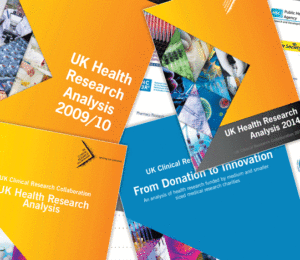 While much of the HRCS documentation focuses on coding, one of the main uses of the HRCS in the UK is to regularly provide a snapshot of nationwide funding of biomedical research. The UK Health Research Analysis report series was begun in 2004 and has provided an invaluable and increasingly comprehensive source of information for strategic decision making.
While much of the HRCS documentation focuses on coding, one of the main uses of the HRCS in the UK is to regularly provide a snapshot of nationwide funding of biomedical research. The UK Health Research Analysis report series was begun in 2004 and has provided an invaluable and increasingly comprehensive source of information for strategic decision making.
In this section:
- Analysis Reports
Provides access the main UK Health Research Analysis reporting series, download the reports and supplementary information. - Analysis Data
Provides access to the complete datasets for the five reports in the UK Health Research Analysis series. - Analysis Tools
A resource to help those interested in replicating the UK Health Research Analysis, including freely available tools and spreadsheets for you to download. - Additional Resources
Some useful external collections of health research information, including the “What’s it worth?” series, WHO Global Observatory and World RePORT.
